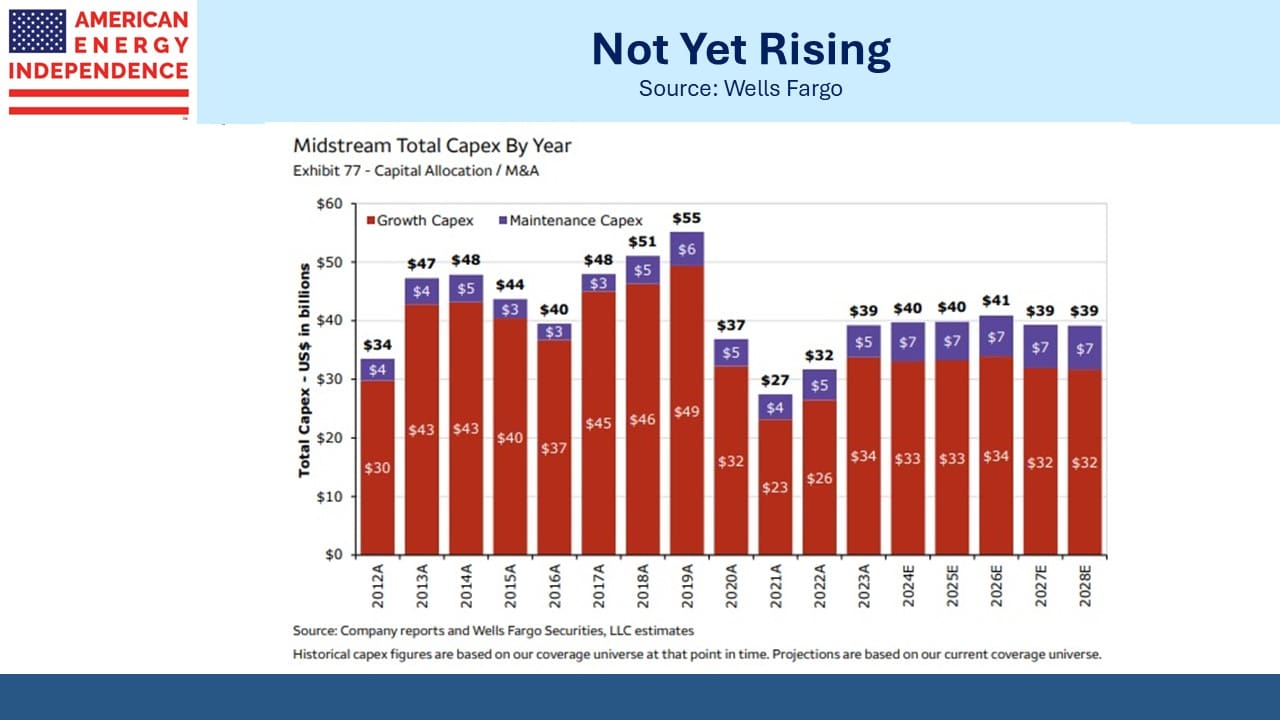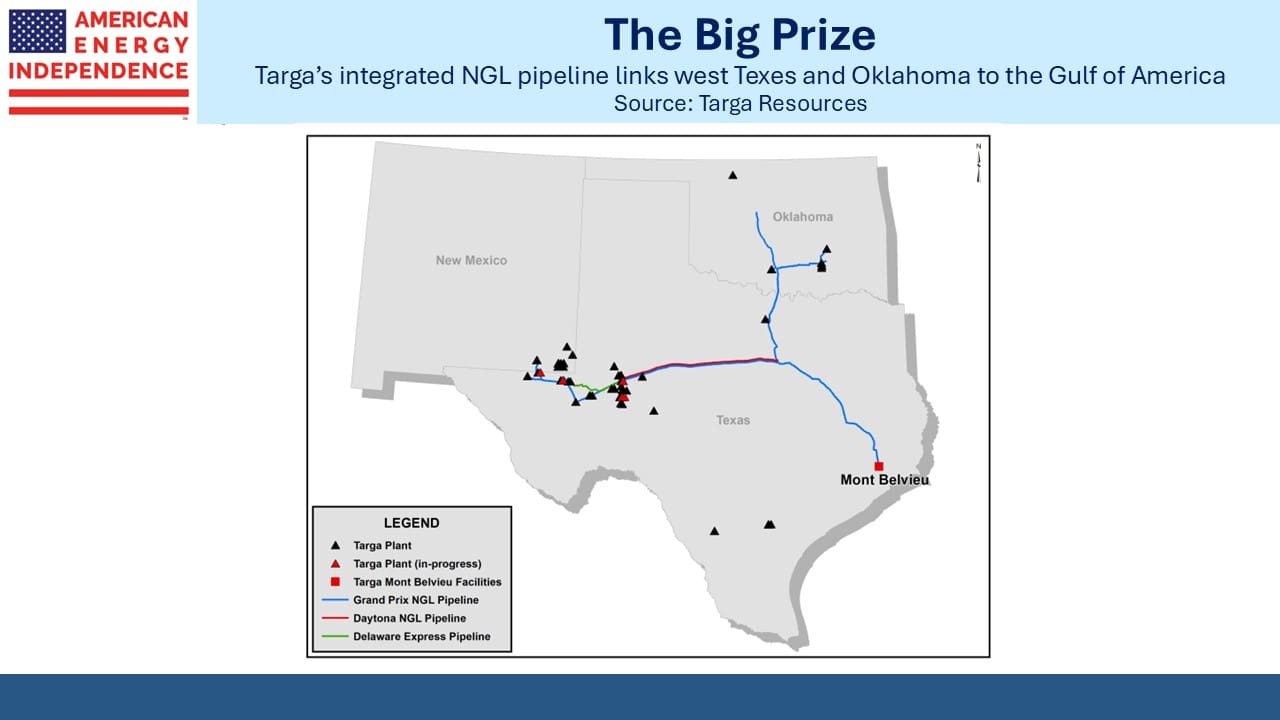Is Capex Back?

/
It seems a lifetime ago, but in the latter stages of the capital bust that was the shale revolution, capex plans were often poorly received. In late 2018 Targa Resources (TRGP) drew the ire of investors when then-CEO Joe Bob Perkins dismissed criticism by calling their spending plans “capital blessings” (see 4Q18 Energy Infrastructure Earnings Wrap Up).
It was around this time that Energy Transfer CEO Kelcy Warren said, “A monkey could make money in this business right now.” following a strong quarter earlier in the year.
Nonetheless, capex plans often failed to draw enthusiasm, and the pandemic was yet to come. On March 20, 2020 when MLP closed end funds were self-immolating (see MLP Closed End Funds – Masters Of Value Destruction), TRGP traded as low at $3.66. Last Wednesday it traded at $211. Your blogger doesn’t regret missing that buying opportunity – I’m happy enough not to have had to sell at the time.
Since then, capital discipline has provided a tailwind for sector performance. Investors cheered reduced spending plans. That wretched little girl Greta and her miserable cohort helped by protesting against reliable energy, which motivated companies to trim spending. Leverage fell, dividends grew and companies began buying back stock.
Hug a climate protester and offer to drive them to their next protest
The sector is moving into a new phase. Climate protesters with their dystopian world view have been discredited. Traditional energy is back in fashion. Trump promotes US oil and gas exports at every opportunity. Data centers are spurring growth in gas-generated power.
Reflective of this emerging trend, Energy Transfer (ET) surprised with an increase in growth capex to $5BN for 2025 along with $1.1BN in maintenance capex. Prior expectations had been for around $4BN in total capex. Among their projects was the first of eight gas power plants that are supporting their own operations. They’ve received requests from 62 power plants and 70 data centers to date.
Williams Companies (WMB) announced two small acquisitions totaling $632MM. Although they have yet to announce a specific data center related deal, the company expects to meet significant new natural gas demand from data centers.
Given the almost 58X recovery in TRGP since the 2020 low, Joe Bob Perkins can probably claim that he was right and his critics, including your blogger, were wrong. Targa became fully integrated from the Permian basin to the Gulf of America in 2019 with the completion of its Grand Prix Natural Gas Liquids (NGL) pipeline.
Subsequent investments including the Daytona NGL Pipeline to expand the Grand Prix system further improved vertical integration. This allowed them to provide services to E&P companies all along the value chain from gathering and processing to fractionation, storage, transportation, and across their export docks. Midstream companies call this multiple opportunities to “touch the molecule.” TRGP’s Grand Prix network moved 872K barrels per day of NGLs during 4Q, with capacity estimated at 1.1 million.
TRGP’s 2025 capex was increased above the $2.3BN expected figure to $2.6-2.8BN. JPMorgan reported this as bringing forward later years’ spending in response to increased producer activity, which sounds like a good thing. They recently announced Delaware Express a 30-inch, 100mile pipeline expansion of Grand Prix into the Delaware Basin in Texas.
Wells Fargo calculates that over the past five years TRGP has invested $13BN to earn a 20% return on invested capital. Only WMB and Cheniere can boast higher returns.
To quote my partner Henry Hoffman, “TRGP is just a wonderful example of how this franchise model works with full integration.”
In spite of these examples, capex is not growing across the sector. Wells Fargo sees little if any increase over the next several years. The opportunities are limited to companies in the natural gas business and others like TRGP that have created a uniquely integrated value chain that is drawing additional demand. Growth spending remains tied to clearly identified projects, which should assure attractive returns.
In other news, President Trump is using every opportunity to promote exports of US oil and gas. At a recent lunch with his Japan counterpart they discussed sending LNG from Alaska. This would require completion of an 800-mile pipeline across Alaska’s north slope, a difficult project that has been contemplated many times over decades but not yet attempted because of difficult terrain.
High level discussions have also taken place with India. Currently there are no US LNG export terminals on the Pacific, although Sempra’s Costa Azul project in Mexico, fed by U.S. gas, is expected to start commercial operations next year.
Given the attention Trump is lavishing on LNG exports, it still seems to us that any indication Europe is planning to increase gas imports from Russia will be poorly received in the White House.
We have two have funds that seek to profit from this environment:

Important Disclosures
The information provided is for informational purposes only and investors should determine for themselves whether a particular service, security or product is suitable for their investment needs. The information contained herein is not complete, may not be current, is subject to change, and is subject to, and qualified in its entirety by, the more complete disclosures, risk factors and other terms that are contained in the disclosure, prospectus, and offering. Certain information herein has been obtained from third party sources and, although believed to be reliable, has not been independently verified and its accuracy or completeness cannot be guaranteed. No representation is made with respect to the accuracy, completeness or timeliness of this information. Nothing provided on this site constitutes tax advice. Individuals should seek the advice of their own tax advisor for specific information regarding tax consequences of investments. Investments in securities entail risk and are not suitable for all investors. This site is not a recommendation nor an offer to sell (or solicitation of an offer to buy) securities in the United States or in any other jurisdiction.
References to indexes and benchmarks are hypothetical illustrations of aggregate returns and do not reflect the performance of any actual investment. Investors cannot invest in an index and do not reflect the deduction of the advisor’s fees or other trading expenses. There can be no assurance that current investments will be profitable. Actual realized returns will depend on, among other factors, the value of assets and market conditions at the time of disposition, any related transaction costs, and the timing of the purchase. Indexes and benchmarks may not directly correlate or only partially relate to portfolios managed by SL Advisors as they have different underlying investments and may use different strategies or have different objectives than portfolios managed by SL Advisors (e.g. The Alerian index is a group MLP securities in the oil and gas industries. Portfolios may not include the same investments that are included in the Alerian Index. The S & P Index does not directly relate to investment strategies managed by SL Advisers.)
This site may contain forward-looking statements relating to the objectives, opportunities, and the future performance of the U.S. market generally. Forward-looking statements may be identified by the use of such words as; “believe,” “expect,” “anticipate,” “should,” “planned,” “estimated,” “potential” and other similar terms. Examples of forward-looking statements include, but are not limited to, estimates with respect to financial condition, results of operations, and success or lack of success of any particular investment strategy. All are subject to various factors, including, but not limited to general and local economic conditions, changing levels of competition within certain industries and markets, changes in interest rates, changes in legislation or regulation, and other economic, competitive, governmental, regulatory and technological factors affecting a portfolio’s operations that could cause actual results to differ materially from projected results. Such statements are forward-looking in nature and involves a number of known and unknown risks, uncertainties and other factors, and accordingly, actual results may differ materially from those reflected or contemplated in such forward-looking statements. Prospective investors are cautioned not to place undue reliance on any forward-looking statements or examples. None of SL Advisors LLC or any of its affiliates or principals nor any other individual or entity assumes any obligation to update any forward-looking statements as a result of new information, subsequent events or any other circumstances. All statements made herein speak only as of the date that they were made. r
Certain hyperlinks or referenced websites on the Site, if any, are for your convenience and forward you to third parties’ websites, which generally are recognized by their top level domain name. Any descriptions of, references to, or links to other products, publications or services does not constitute an endorsement, authorization, sponsorship by or affiliation with SL Advisors LLC with respect to any linked site or its sponsor, unless expressly stated by SL Advisors LLC. Any such information, products or sites have not necessarily been reviewed by SL Advisors LLC and are provided or maintained by third parties over whom SL Advisors LLC exercise no control. SL Advisors LLC expressly disclaim any responsibility for the content, the accuracy of the information, and/or quality of products or services provided by or advertised on these third-party sites.
All investment strategies have the potential for profit or loss. Different types of investments involve varying degrees of risk, and there can be no assurance that any specific investment will be suitable or profitable for a client’s investment portfolio.
Past performance of the American Energy Independence Index is not indicative of future returns.




Leave a Reply
Want to join the discussion?Feel free to contribute!